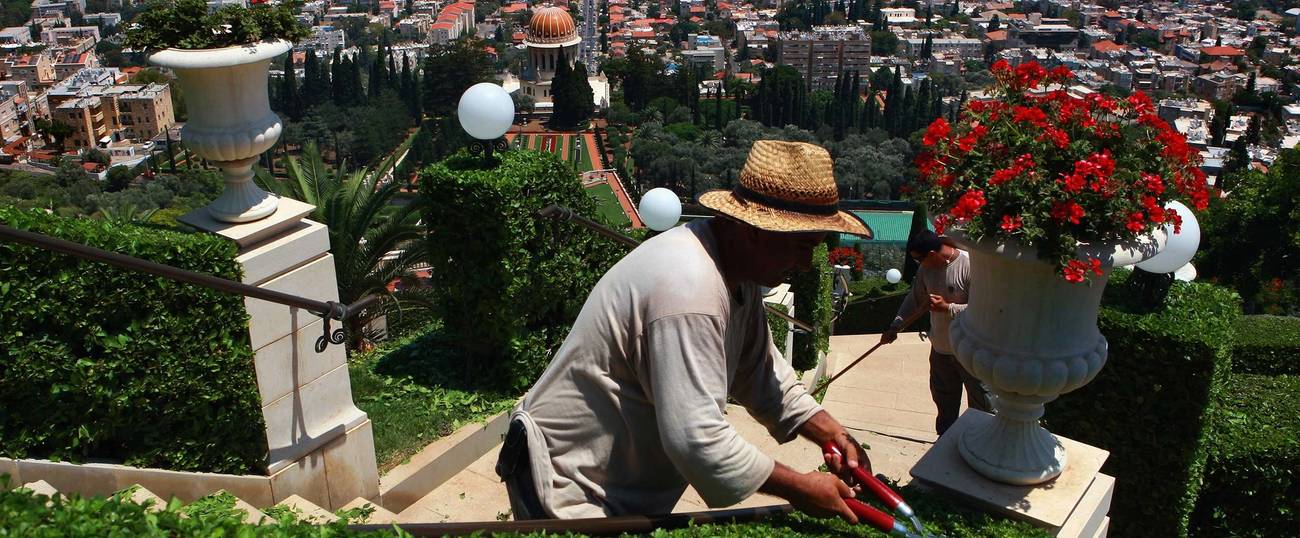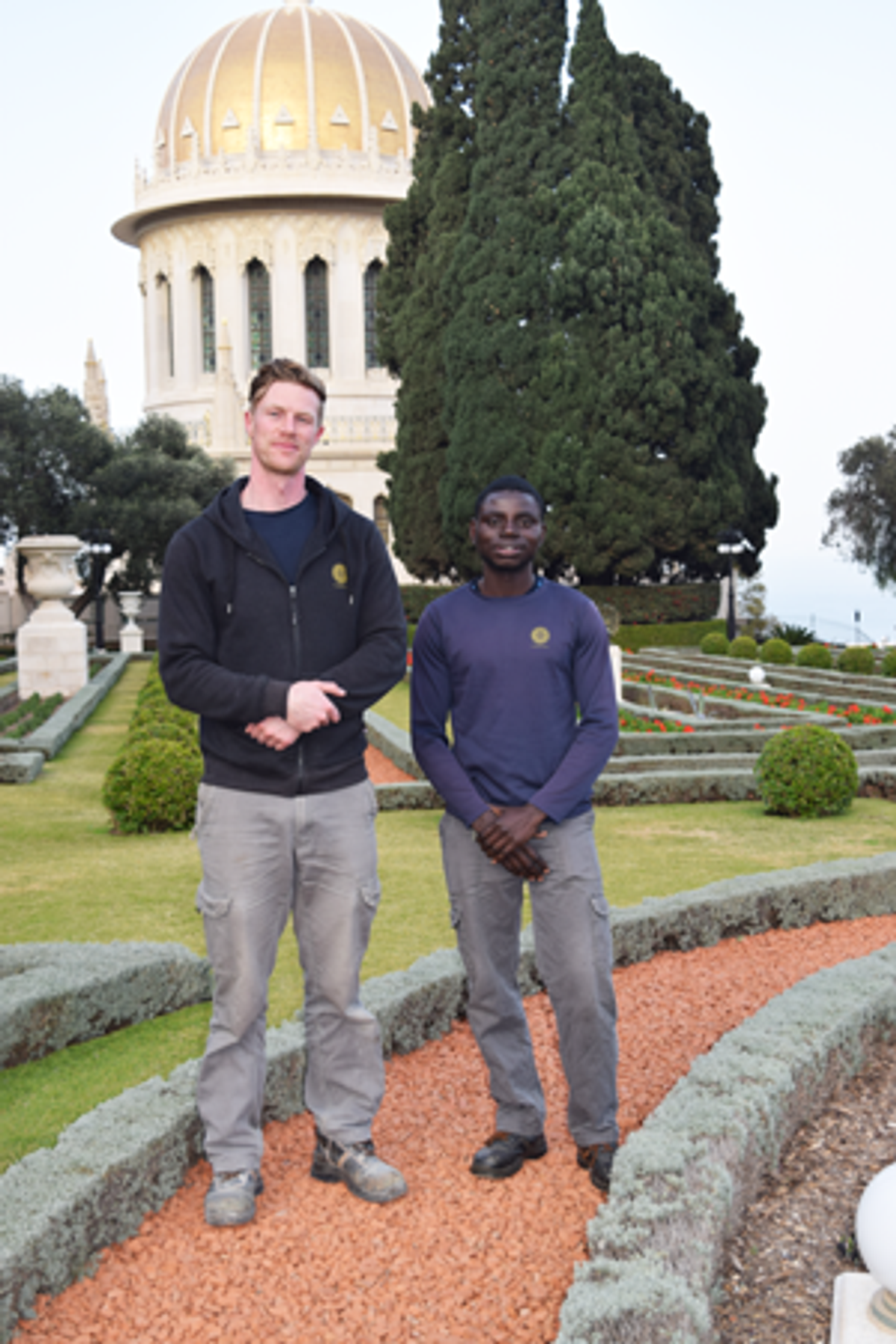Haifa’s Pilgrims
Every year, hundreds of volunteers from around the world come to Israel to tend the Baha’i World Centre and its famous gardens




For Sydney Kopokosu there are always lawns to mow, dead leaves to pick up, and bushes to trim. These simple but constant tasks are what keep the famous terraced gardens around the Baha’i World Centre on the slope of Haifa’s Mount Carmel in pristine condition.
“For me, this work is a dream,” said Kopokosu, 28. Originally from Zambia, he is one of about 600 international volunteers from the Baha’i faith who come to Israel and dedicate a few years of their lives tending to the gardens, mausoleum shrines, and other holy places and institutions of one of the world’s youngest religions—which began in 19th-century Iran and, through a dramatic turn of events, came to be headquartered in Haifa.
“All my life I saw pictures of Mount Carmel, and I was inspired by its beauty,” said Kopokosu, whose grandfather was one of Zambia’s earliest converts to the Baha’i faith, a monotheistic religion that preaches the spiritual unity and equality of all humanity, and the universal truth of all other established faiths. “So being here is very emotional.”

Trimming and watering the red geraniums, towering palm trees, and brilliant green grass in these gardens makes this time of year—the 19 days of fasting and reflection that precede the Baha’i New Year, or Nawruz, on March 21—even more meaningful, said Kopokuso, who carries out his manual labor despite not eating or drinking during daylight hours.
“I am really following in the footsteps of our founders as I take care of these gardens and connect with people from all over the world,” said Kopokosu, who works as an educator back home.
Baha’i Nawruz celebrations usually include festive meals in people’s homes, often also with guests from outside the Baha’i community. In Israel, Baha’i leaders will host a reception for local government and diplomatic officials at Jerusalem’s David Citadel Hotel, which will include speeches and musical performances. The Baha’i calendar is a solar calendar, consisting of 19 months, each with 19 days, with the addition of four or five extra “inter-calendar” days each year.
The coming year will be 176, signifying that it was 176 years ago that the Baha’is believe their new revelation began. But this new year will be one of special reflection for Baha’is, as they mark 200 years since the birth of Ali Muhammed Shirazi, a Persian Shiite Muslim merchant who in 1844 claimed to be a messenger of God, and set into motion the founding of what has become one of the world’s most successful new religions. According to the Baha’i World Centre, there are about 5 million adherents worldwide, with communities in 170 countries; when the first world congress was held in Haifa in 1963, there were just 400,000 followers in 56 countries.
For the Baha’is, Shirazi is a prophet called “the Bab,” which means “the gate” in Arabic, as he is seen as the beginning of a new era of religion and world order. It is the remains of the Bab that are entombed in the golden domed shrine at the top of Mount Carmel, a site that draws about 4,000 foreign Baha’i pilgrims as well as many more local and international tourists each year. Meanwhile, a 150-year-old Baha’i policy still bans the spreading of the religion locally, resulting in no official Baha’i community in Israel, aside from the international volunteers.
“Everyone knows about the Baha’i gardens, but they know very little about the faith,” said Steve Sarowitz, a Jew from Chicago who adheres to the Baha’i faith, but also still considers himself Jewish, attending synagogue and recently celebrating his son’s bar mitzvah. “I still believe in the Torah, God, and Moses, but I am also a Baha’i,” Sarowitz said, explaining that becoming a Baha’i does not include giving up previous beliefs because the faith recognizes that all religions contain universal truths, and sees beauty in all cultures. He is the executive producer of The Gate, a film about Shirazi’s life, which premiered last year on ABC and has been shown in hundreds of private screenings around the world. “It really is a fascinating story,” he said.
*
The Baha’i story began in Shiraz, Iran, in 1844 when the 24-year-old Shirazi, a merchant, began saying he was a messenger of God, and talking about the coming of a new era, in which all humanity would be united and prosper. He quickly gained followers because his message came at a time of messianic fervor, political upheaval, and corruption amid the Shia clerics who held an enormous amount of power in Iran, explained Nader Saiedi, an Iranian-born sociologist who teaches Baha’i history at UCLA. That year—1844—marked the 1,000th anniversary of the disappearance of the 12th Shia imam, whom followers believed would one day come back as a savior, bringing an era of peace and justice.
“There was a yearning among a lot of the people for some kind of changes, politically and religiously,” Saiedi said. “There was a big expectation that something could happen that year.” But Shirazi, who called himself the Bab, also criticized Islamic leaders and dogma, called for gender equality, and advocated a new holy book to supersede the Quran, ultimately calling for a new religion.
“He was very radical,” Saiedi said.
Accused of being an apostate, Shirazi was jailed and eventually executed by a government firing squad in 1850. Iranian authorities also persecuted and killed many of his followers, especially after two of the Bab’s followers tried to assassinate the shah in 1852.
Soon, one devoted follower, Mirza Husayn Ali, became the leader of the decimated group, eventually saying he was the promised teacher, or Baha’ullah, whom the Bab had prophesied would come. Again seeing a threat to their power, Iranian authorities exiled Baha’ullah along with dozens of his relatives and followers to Baghdad, then Istanbul, then eventually to the Ottoman Empire’s notorious citadel in Akko in Palestine.
In prison, and later under house arrest in Akko, Baha’ullah wrote thousands of pages, developing what would become the religion’s main tenets. Although he continued to gain followers in Iran and Iraq—some of whom journeyed to Akko to view his dwelling from afar—he temporarily banned spreading the new faith in all of Ottoman Palestine. This was because he did not want to risk stirring up trouble with the local Muslim clerics and Ottoman officials, Saiedi said: “He made this decision to guarantee his safety so he could continue his revelations and writings.”
It was only after Baha’ullah’s death in 1892 that the religion began to emerge on the world stage, with Baha’ullah’s son Abdul Baha traveling to the United States and Europe, speaking about the new religion and gaining followers. The Baha’is also began to build a permanent home in Palestine. Baha’ullah’s tomb near Akko emerged as a holy place, attracting pilgrims and becoming the place that all Baha’is faced during their daily prayers—the only prescribed ritual in the new religion. A stone mausoleum was also erected on Mount Carmel in Haifa, where Baha’i officials say the remains of the Bab were buried in 1906, after being smuggled out of Iran. Gardens were planted around it, laying the groundwork for its eventual grandeur.
When the state of Israel was established in 1948, the government granted the Baha’is tax-exempt status as a religious group, and permission for the massive development of Mount Carmel. By the 1950s, the Baha’is, with money raised by followers abroad, had built the elaborate golden-dome structure over the Bab’s mausoleum along with a large white marble building modeled on the Parthenon in Athens that houses the religion’s archives and administrative center.
By the 1950s, the number of local Baha’i residents was “minuscule,” according to Randall Geller, assistant professor of history at Bentley University, who has studied the development of the Baha’i religion. Most of those who had come to Akko with Baha’ullah—and their descendants—had fled during Israel’s War of Independence, or had been ordered to leave the country in a power struggle for leadership by Shoghi Effendi Rabbani, the last leader of the religion, who passed away in 1957, leaving no successor, Geller explained.
To this day, Israel is the only country where the Baha’i leadership, made up of a board of elected officials from around the world that meets in Haifa, bans the spreading of the faith.
Just like in Baha’ullah’s time, they do not want to risk angering local authorities, or breaking Israel’s laws on religious proselytizing, Saiedi said.
“It is still more important for them now that they have a safe base from which to spread the faith globally,” Saiedi said. The religion is spreading most rapidly in developing countries, including in Latin America, Asia, and Africa, Saiedi said, while Baha’is in Iran, Yemen, and other Middle Eastern countries continue to face persecution.
Meanwhile, the upkeep of the shrines and administrative centers in Haifa, including an ongoing project to translate the writings of the Bab and Baha’ullah into more languages, is completely reliant on volunteers and financial donations from abroad.
“Everybody brings their different talents,” said Carmel Irandoust, the deputy secretary general of the Baha’i community, who was born in Paris to Iranian parents who named her after the revered mountain in Haifa.
For the volunteers in Haifa, their time here is an important source of inspiration. “I now have stronger bonds with this place, and feel I have grown spiritually,” said Intalik Milne, who has volunteered as a gardener since 2016, and will return home to Greenland in April. In the Baha’i faith, which has no rituals other than brief daily prayers that followers recite alone in any language of their choosing, spiritual connection is important, Milne explained. As his mission approaches its end, he will try to visit the Bab’s shrine as often as possible. Each time before he enters he walks along the red rock paths in the gardens, then around the shrine itself several times, before leaving his shoes at the door and going inside the building, which is decorated with elaborate carpets and chandeliers, and smells overwhelmingly like roses due to the ubiquitous vases of these flowers, freshly cut form the surrounding gardens.
“More and more I can relate to the person of the Bab,” Milne said. “It really is a special opportunity to be here.”
***
Like this article? Sign up for our Daily Digest to get Tablet magazine’s new content in your inbox each morning.
Sara Toth Stub is a Jerusalem-based American journalist who has written for The Wall Street Journal, Dow Jones Newswires, Associated Press, and other publications.